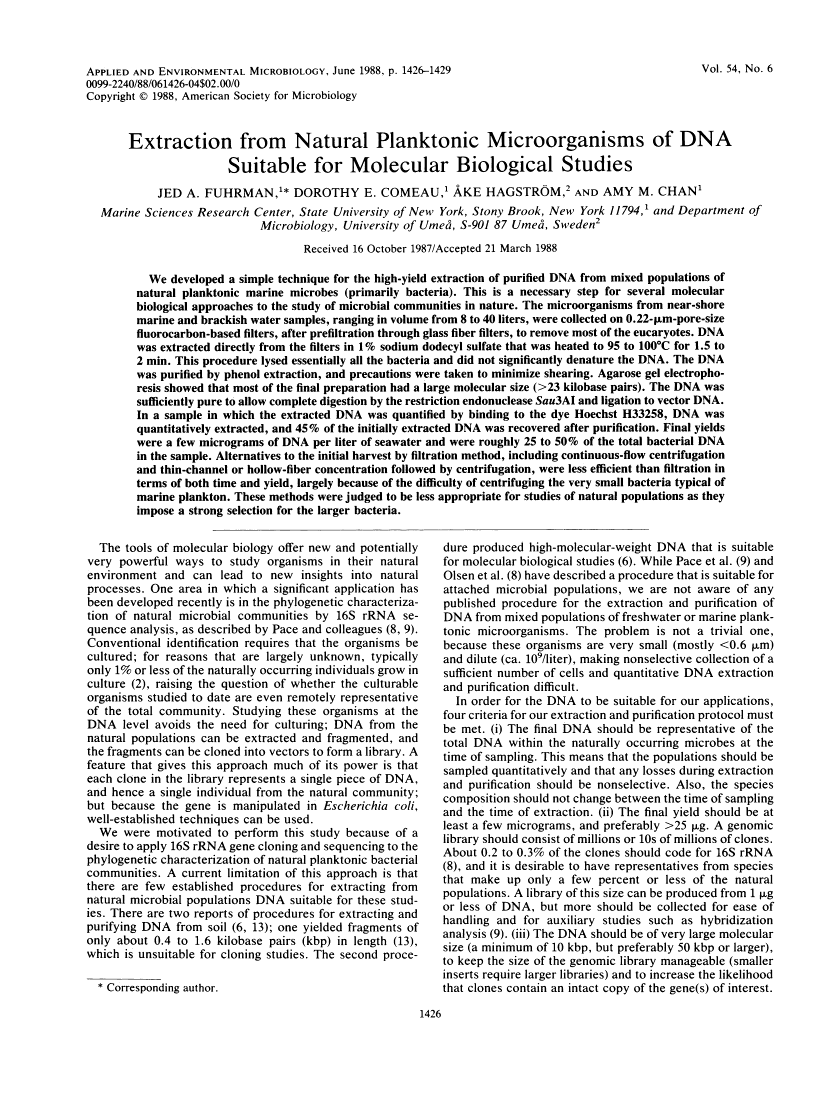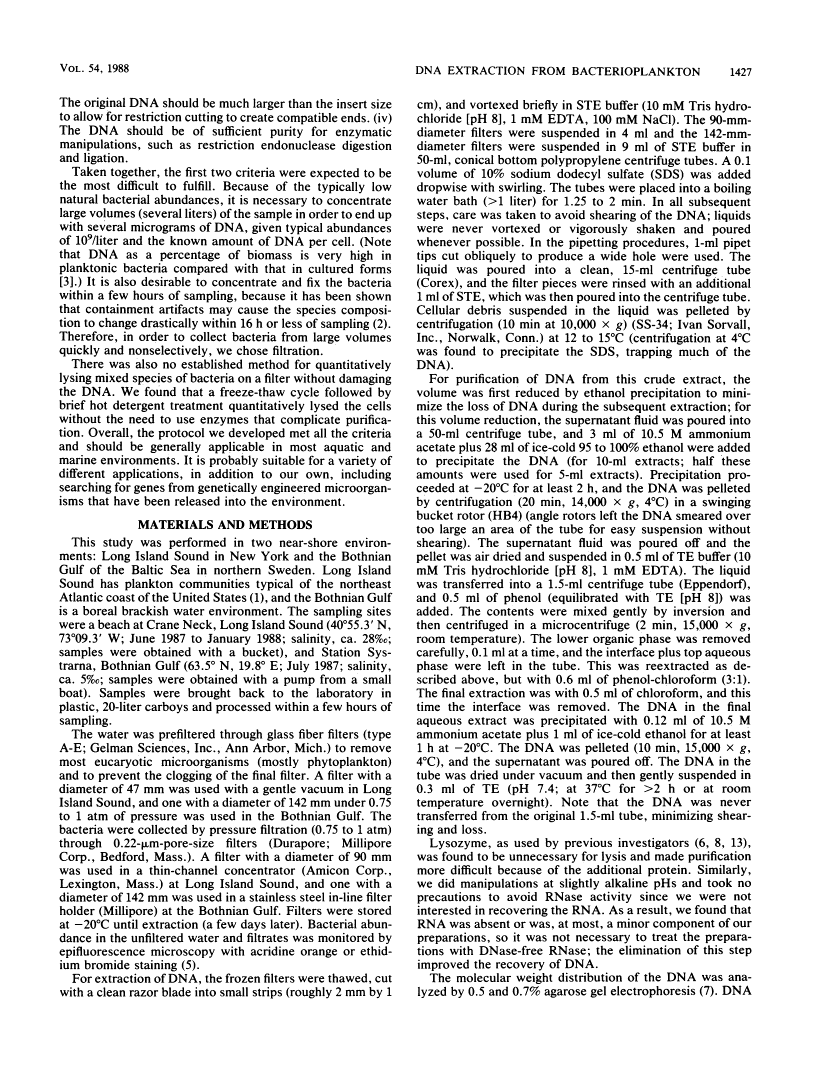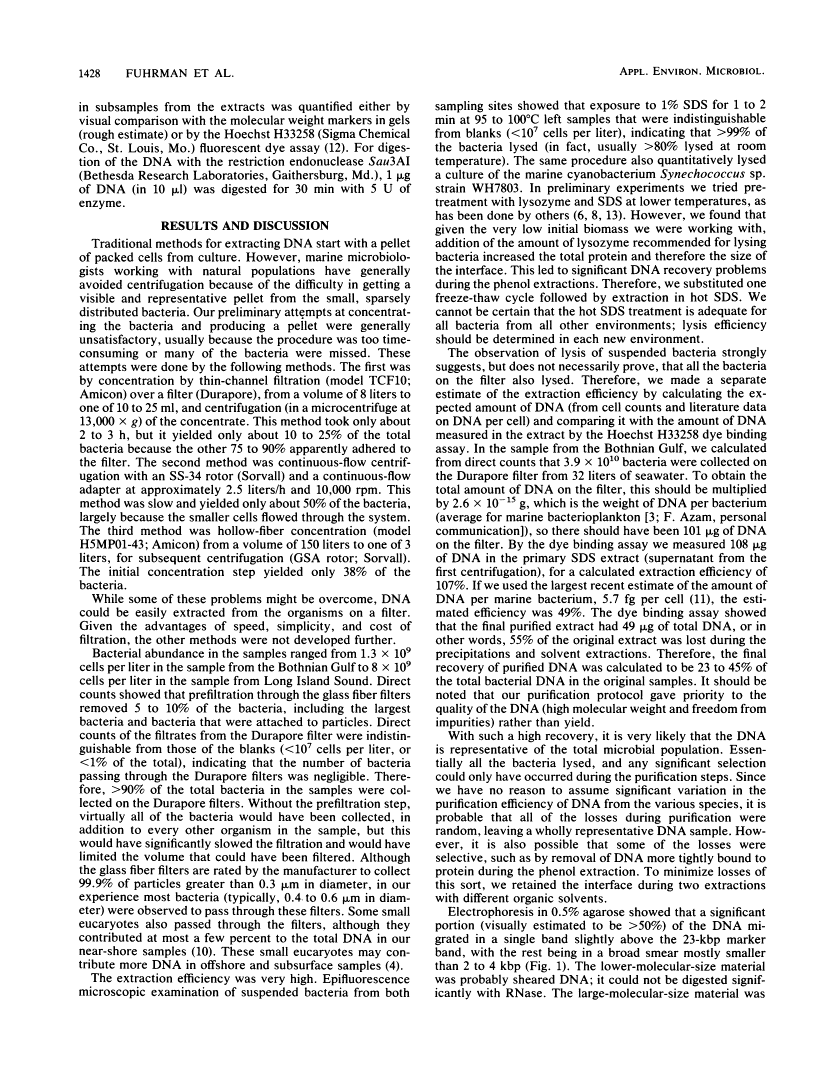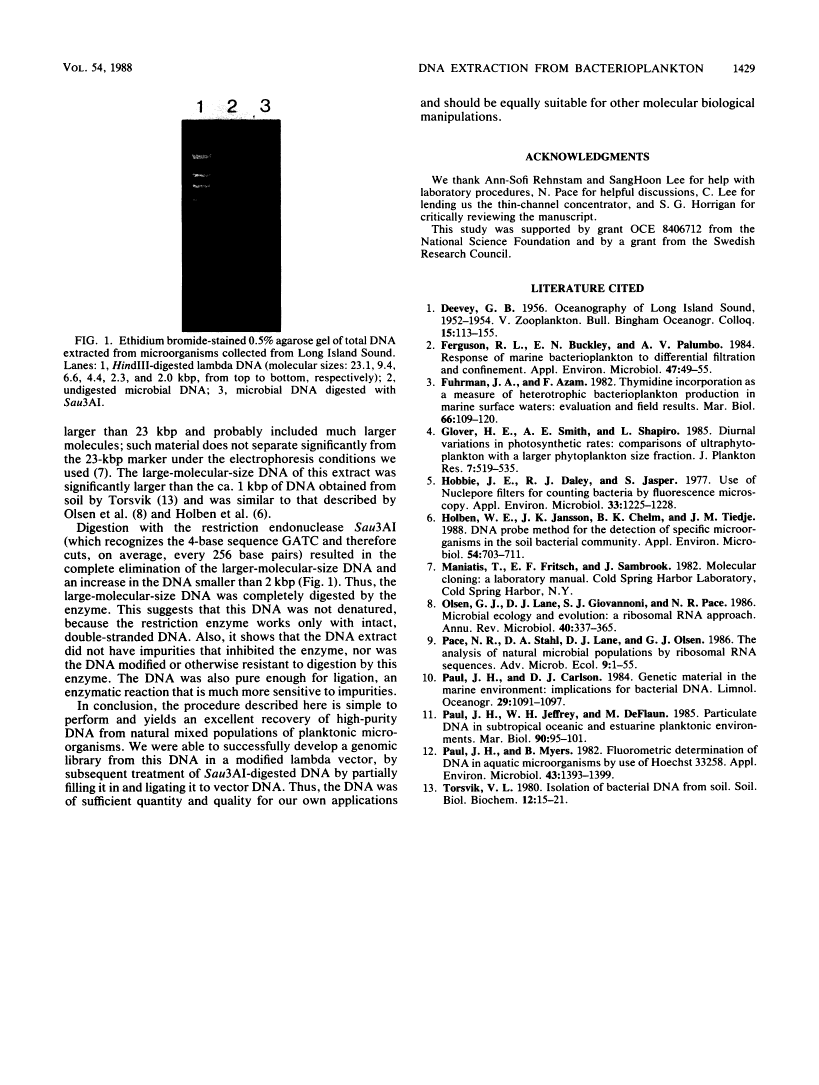Abstract
Free full text

Extraction from Natural Planktonic Microorganisms of DNA Suitable for Molecular Biological Studies
Abstract
We developed a simple technique for the high-yield extraction of purified DNA from mixed populations of natural planktonic marine microbes (primarily bacteria). This is a necessary step for several molecular biological approaches to the study of microbial communities in nature. The microorganisms from near-shore marine and brackish water samples, ranging in volume from 8 to 40 liters, were collected on 0.22-μm-pore-size fluorocarbon-based filters, after prefiltration through glass fiber filters, to remove most of the eucaryotes. DNA was extracted directly from the filters in 1% sodium dodecyl sulfate that was heated to 95 to 100°C for 1.5 to 2 min. This procedure lysed essentially all the bacteria and did not significantly denature the DNA. The DNA was purified by phenol extraction, and precautions were taken to minimize shearing. Agarose gel electrophoresis showed that most of the final preparation had a large molecular size (>23 kilobase pairs). The DNA was sufficiently pure to allow complete digestion by the restriction endonuclease Sau3AI and ligation to vector DNA. In a sample in which the extracted DNA was quantified by binding to the dye Hoechst H33258, DNA was quantitatively extracted, and 45% of the initially extracted DNA was recovered after purification. Final yields were a few micrograms of DNA per liter of seawater and were roughly 25 to 50% of the total bacterial DNA in the sample. Alternatives to the initial harvest by filtration method, including continuous-flow centrifugation and thin-channel or hollow-fiber concentration followed by centrifugation, were less efficient than filtration in terms of both time and yield, largely because of the difficulty of centrifuging the very small bacteria typical of marine plankton. These methods were judged to be less appropriate for studies of natural populations as they impose a strong selection for the larger bacteria.
Full text
Full text is available as a scanned copy of the original print version. Get a printable copy (PDF file) of the complete article (899K), or click on a page image below to browse page by page. Links to PubMed are also available for Selected References.
Images in this article
Click on the image to see a larger version.
Selected References
These references are in PubMed. This may not be the complete list of references from this article.
- Ferguson RL, Buckley EN, Palumbo AV. Response of marine bacterioplankton to differential filtration and confinement. Appl Environ Microbiol. 1984 Jan;47(1):49–55. [Europe PMC free article] [Abstract] [Google Scholar]
- Hobbie JE, Daley RJ, Jasper S. Use of nuclepore filters for counting bacteria by fluorescence microscopy. Appl Environ Microbiol. 1977 May;33(5):1225–1228. [Europe PMC free article] [Abstract] [Google Scholar]
- Holben William E, Jansson Janet K, Chelm Barry K, Tiedje James M. DNA Probe Method for the Detection of Specific Microorganisms in the Soil Bacterial Community. Appl Environ Microbiol. 1988 Mar;54(3):703–711. [Europe PMC free article] [Abstract] [Google Scholar]
- Olsen GJ, Lane DJ, Giovannoni SJ, Pace NR, Stahl DA. Microbial ecology and evolution: a ribosomal RNA approach. Annu Rev Microbiol. 1986;40:337–365. [Abstract] [Google Scholar]
- Paul JH, Myers B. Fluorometric determination of DNA in aquatic microorganisms by use of hoechst 33258. Appl Environ Microbiol. 1982 Jun;43(6):1393–1399. [Europe PMC free article] [Abstract] [Google Scholar]
Associated Data
Articles from Applied and Environmental Microbiology are provided here courtesy of American Society for Microbiology (ASM)
Full text links
Read article at publisher's site: https://doi.org/10.1128/aem.54.6.1426-1429.1988
Read article for free, from open access legal sources, via Unpaywall:
https://aem.asm.org/content/aem/54/6/1426.full.pdf
Free after 4 months at aem.asm.org
http://aem.asm.org/cgi/reprint/54/6/1426
Free to read at aem.asm.org
http://aem.asm.org/cgi/content/abstract/54/6/1426
Citations & impact
Impact metrics
Article citations
Long-read powered viral metagenomics in the oligotrophic Sargasso Sea.
Nat Commun, 15(1):4089, 14 May 2024
Cited by: 0 articles | PMID: 38744831 | PMCID: PMC11094077
Microbial community and network responses across strong environmental gradients: How do they compare with macroorganisms?
FEMS Microbiol Ecol, 100(3):fiae017, 01 Feb 2024
Cited by: 2 articles | PMID: 38327185 | PMCID: PMC10894034
Ubiquitous, B12-dependent virioplankton utilizing ribonucleotide-triphosphate reductase demonstrate interseasonal dynamics and associate with a diverse range of bacterial hosts in the pelagic ocean.
ISME Commun, 3(1):108, 03 Oct 2023
Cited by: 1 article | PMID: 37789093 | PMCID: PMC10547690
Bacterial diversity in the aquatic system in India based on metagenome analysis-a critical review.
Environ Sci Pollut Res Int, 30(11):28383-28406, 21 Jan 2023
Cited by: 0 articles | PMID: 36680718 | PMCID: PMC9862233
Review Free full text in Europe PMC
Organic and inorganic nutrients modulate taxonomic diversity and trophic strategies of small eukaryotes in oligotrophic oceans.
FEMS Microbes, 4:xtac029, 07 Dec 2022
Cited by: 1 article | PMID: 37333435 | PMCID: PMC10117809
Go to all (117) article citations
Similar Articles
To arrive at the top five similar articles we use a word-weighted algorithm to compare words from the Title and Abstract of each citation.
Variables influencing extraction of nucleic acids from microbial plankton (viruses, bacteria, and protists) collected on nanoporous aluminum oxide filters.
Appl Environ Microbiol, 80(13):3930-3942, 18 Apr 2014
Cited by: 15 articles | PMID: 24747903 | PMCID: PMC4054216
Rapid method for direct extraction of DNA from soil and sediments.
Appl Environ Microbiol, 57(4):1070-1074, 01 Apr 1991
Cited by: 276 articles | PMID: 1647749 | PMCID: PMC182847
Thin polyester filters as versatile sample substrates for high-pressure freezing of bacterial biofilms, suspended microorganisms and adherent eukaryotic cells.
J Microsc, 274(2):92-101, 12 Mar 2019
Cited by: 0 articles | PMID: 30802953
Upflow anaerobic sludge blanket reactor--a review.
Indian J Environ Health, 43(2):1-82, 01 Apr 2001
Cited by: 13 articles | PMID: 12397675
Review










